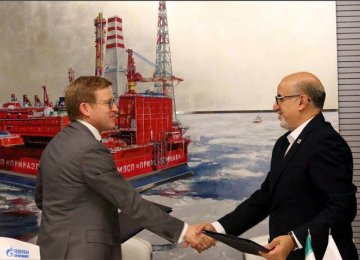The Oil Industries Engineering and Construction Company (OIEC) and Russia's Gazprom Neft signed a memorandum of understanding on Thursday in the Russian city of St. Petersburg to join forces in the assessment of geological potentials of Changuleh and Azar oilfields in Mehran, Ilam Province, near the border with Iraq.
The agreement was signed by first deputy CEO of Gazprom Neft, Vadim Yakovlev, and OIEC Managing Director Behzad Mohammadi, the National Iranian Oil Company's news portal reported.
The parties have agreed to hold joint consultations with NIOC on the evaluation, exploration and development of assets offered to investors, and to consider additional opportunities for cooperation in Iran.
The news portal added that Gazprom Neft clinched a non-disclosure agreement with OIEC last year to study the fields, yet the two sides had to hold a number of meetings to thrash out technical, financial and legal issues.
Russia's energy major presented a preliminary plan for developing two Iranian oil and gas fields—Changuleh and Azar—in April, while the final proposal is expected to be presented after conducting more comprehensive studies.
Having resolved all contractual ambiguities, a delegation from OIEC headed by its managing director paid a visit to Russia to conclude an MoU to pave the way to sign a final deal under the new Iran Petroleum Contract model to expand the fields.
"The agreement does not grant Gazprom Neft and OIEC drilling rights and does not restrict the company from negotiating and entering into agreements with third parties," Yakovlev added.
According to Yakovlev, the company currently seeks the development of only two Iranian oil fields, but it is open to explore other areas of cooperation.
"Only Changuleh and Azar for now," Yakovlev said in an interview. "We are ready to consider other options… regarding the development of Iranian oilfields."
Changuleh Oilfield is estimated to hold more than 4 billion barrels of heavy crude in place. Iran hopes to start production from the oilfield at a rate of 15,000 barrels per day and boost output to 65,000 bpd under a five-year development plan.
According to Mohammadi, the first phase of production from Azar Oilfield in the west, with a capacity of 15,000 barrels per day, commenced in March after a long delay.
The field holds 2.5 billion barrels of crude oil and is expected to produce up to 65,000 bpd as soon as the second phase is completed in 2018.
Pointing to the extended delay, Mohammadi said Russia’s oil company Lukoil, Norway's renewable energy company Norsk Hydro ASA, Malaysia's Petronas and Russia's Gazprom Neft were among companies that started developing the oilfield in 2003, but work was delayed due to international restrictions over Iran's nuclear program.
Underscoring the fact that the field was considered a drillers' nightmare given the sequence of its low- and high-pressure layers, and the large number of tubes for drilling and lining of the wells, Mohammadi said hydraulic fracturing was another challenge in the field, which was solved with acid fracturing, a popular method for improved oil recovery.
Asked about Azar Oilfield's crude quality, Mohammadi said the oil's API, a measure of how heavy or light a petroleum liquid is compared to water, stands at 33.











Add new comment
Read our comment policy before posting your viewpoints